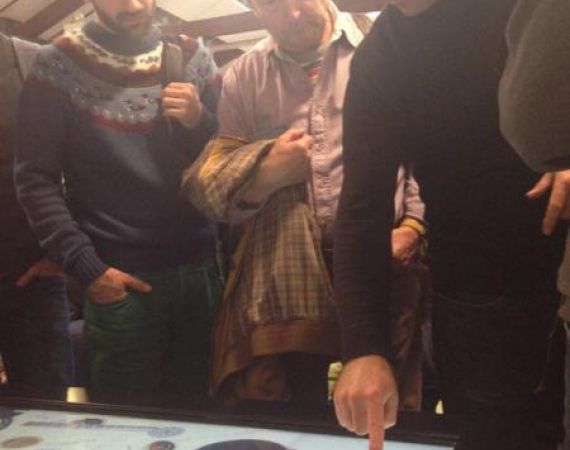Posted on Sat 24 Aug 2013
Designing for touchy subjects: Lunchtime Talk write-up
On Friday 11 October we were joined in the Studio by S'unya Dickman, who is Head of Client Side Technology at digital agency Aerian. The Studio has recently become host to one of Aerian's latest creations, a touchable table-top. The touch table demonstrates the outcome of Aerian’s project ‘How…

On Friday 11 October we were joined in the Studio by S'unya Dickman, who is Head of Client Side Technology at digital agency Aerian. The Studio has recently become host to one of Aerian's latest creations, a touchable table-top. The touch table demonstrates the outcome of Aerian’s project ‘How the pictures learn to walk’, which brings some of the earliest forms of cinema such as the Zoetrope to life in a decidedly 21st century way. S’unya spoke to us about the touch table and explained what to take into account when designing for touchable inferfaces.
Designing for Touchable Interfaces
S’unya began the Lunchtime talk by explaining the principles which he and Aerian follow when designing for a Touchable Interface:
1) It needs to be visually engaging.
2) It needs to be fun to interact with.
3) It needs to be intuitive so the user feels confident and empowered using it.
4) It needs to be interesting – so the user can keep on finding new things to do.
S’unya explained that as long as your user feels empowered and is having fun they will continue to use the touchable interface.
He then explained that designing for a touch table brings with it a set of design considerations that are perhaps more challenging than smaller items such as mobile phone interfaces. Size is one of these challenges, as touch tables are much bigger than the monitors they are designed on. S’unya explained that he always encourages his team to test out designs as early as they can in the project because an image or design on the screen can look completely different when enlarged. He went on to explain that as touch tables are also normally in a public space people are more fearful of interacting with the object because they worry about making a fool out of themselves and getting it wrong. The key is making gestures and actions that you use to operate the touch table intuitive so people know how to begin interacting with the tables.
'How the pictures learnt to walk'
The project 'How the pictures learnt to walk' was devised by Dr Birgit Beumers, an expert in Russian cinema and theatre formerly at the University of Bristol's School of Modern Languages, and Julia Bracegirdle, Senior Lecturer in Animation at the Bristol School of Animation, UWE, in collaboration with Aerian Studio.
S’unya explained that to engage with audiences, they worked hard to create an application that is as fun as it is immersive, allowing users to create their own on screen animations. The user does this by dragging and dropping a set of images into each of the three devices; the Zoetrope, the Phenakistascope and the Kinora, and then using touch gestures to spin or crank the devices, building up momentum in order to animate them.
S’unya told us that the touch table is the most complex HTML5 application they have made to date. They dedicated a lot of time to refining the application so that the 40” touch table gives the closest visual experience as possible the real original device. You can see a demonstration in a video here. All the images and animation used in ‘How the pictures learnt to walk’ are from the archives of the National Media Museum, the Museo del Precinema in Padua and early animation work by Alexander Shiryaev digitised by Aardman Animations Ltd.
Before being displayed in the Studio the touch table was also at the University of Bristol Theatre Collection and the Museo del Precinema in Padova, Italy and they hope to exhibit it at various other museums and collections in the future.
Walking Pictures
S’unya then spoke about the iPad app they have developed called Walking Pictures which is a redesigned version of the touch table. He explained that the whole interface had to be completely redesigned because the different way that people interact with the devices and the size of the screen. Check it out on your iPad here.
The touchtable will be with us in the Studio over the next couple of weeks so why not join us one Friday afternoon for Open Studio and have a play. You can find out more about Open Studio and our upcoming programme of Lunchtime Talks here.